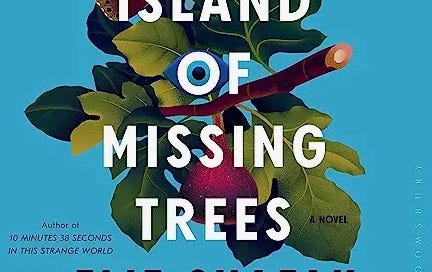BookLife Review: The Island of Missing Trees, by Elif Shafak
magical realism, historical fiction, Cyprus, Greeks and Turks, London, botany, entymology, fig tree
The Island of Missing Trees by Elif Shafak is a beautifully written story of thwarted love during a civil war set against the partition of Cyprus in 1974. The people of the island were a mix of Greeks and Turks and Christians and Muslims. Before the invasion of the island by the Turks, and the ensuing civil war, there certainly were tribes and feuds, distrust and animosities arising from the fear of what is “other” in a small community. Once military hostilities broke out, and lives were lost and family members went missing, the divisions grew with the resentments.
Upon this tableau, we meet our Cypriot Romeo and Juliet, Kostas and Defne, a young Greek man and a young Turkish woman. They fall in love and meet secretly to avoid the disapproval of their families and the enforced separation that would bring. As the violence escalates, Kostas’ single mother sends him, the last of her three sons, to her brother in England. His departure coincides with a lock-down due to the violence and he must leave without explaining to Defne. She is devastated and left alone to contend with her fate. Twenty-five years later, Kostas returns to the island to seek forgiveness from Defne and to attempt a reconciliation. By then Defne has become an archaeologist and human rights activist working to recover and identify the remains of the hundreds of citizens of Cyprus who went missing during the conflict. She struggles with the decision to forgive Kostas and reconcile. Ultimately they move to London and have a child, Ada, who is our anchor in the present day. Ada, at times reluctantly and other times eagerly, explores her mixed cultural heritage.
Kostas is a botanist, as deeply committed to the needs of plants and trees as Defne is to people. Herein lies the author’s magical realism device. Shafak annoints a fig tree, ficus carica, as an occasional narrator of the events in the lives of the characters in the stories. The fig tree grows in a taverna in the village and bears witness to the love and lovers, families, loss, grief and war it witnesses there. Kostas later brings a cutting from the tree to London where it grows again under his care. If the author had limited the fig tree’s role to the scientifically recognized phenomenon of plants responding to voices, experiencing traumas of its own and communicating information about climate and water to other trees through a shared root system, I might have taken that limited magical realism ride and willingly suspended my belief. But here, Shafak endows the fig tree with greater power, bestowing upon it the discovery of key pieces of history and plot. These revelations would have felt more real and grounded the story more fully if they had been placed in the hands and minds of the humans in the story, rather than in the roots and branches of an omniscient narrating tree.
For fans of magical realism, this device may not prove troubling at all, and they may well delight in the author’s inventiveness and her ability to stretch our minds to contemplate the connection between all living things, across species.




